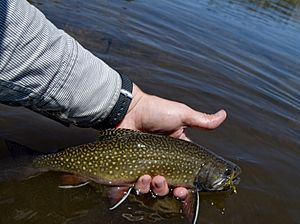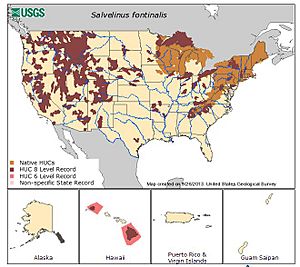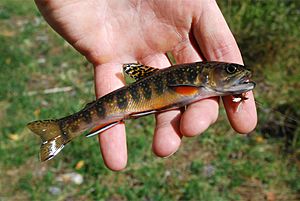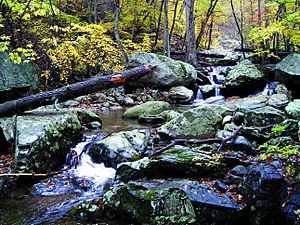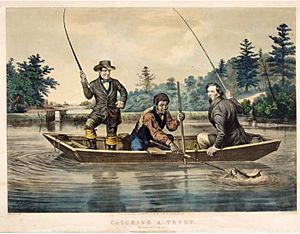Brook trout facts for kids
Quick facts for kids Brook trout |
|
|---|---|
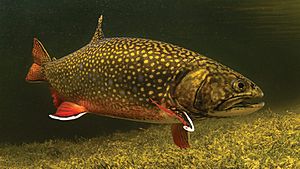 |
|
| Conservation status | |
| Scientific classification | |
| Genus: |
Salvelinus
|
| Species: |
fontinalis
|
| Subspecies | |
|
S. f. agassizii (Garman, 1885)† |
|
The brook trout (Salvelinus fontinalis) is a type of freshwater fish that belongs to the salmon family. Even though it's called a "trout," it's actually a kind of fish called a "char." These fish are originally from Eastern North America, including parts of the United States and Canada. However, people have introduced them to other places like Iceland, Europe, and Asia.
You might hear the brook trout called by other names, like "eastern brook trout," "speckled trout," or "brook charr." Some special groups of brook trout are known as "coaster trout" or "salters." The brook trout is so important that it's the official state fish for nine U.S. states, including Michigan and New York. It's also the Provincial Fish of Nova Scotia in Canada.
Contents
What is a Brook Trout?
The brook trout was first described by a scientist named Samuel Latham Mitchill in 1814. Its scientific name, "fontinalis," comes from a Latin word meaning "of a spring or fountain." This name fits perfectly because these fish love clear, cold streams and ponds.
Even though it's commonly called a trout, the brook trout is actually a "char." Other chars found in North America include the lake trout and Arctic char.
Different Kinds of Brook Trout
Scientists have found a few different types of brook trout. There are two main subspecies and three ecological forms, which are types that have adapted to different environments.
Subspecies of Brook Trout
- The aurora trout (S. f. timagamiensis) is a rare subspecies found in just two lakes in Ontario, Canada.
- The silver trout (S. f. agassizii) is a subspecies that is now extinct. It was last seen in New Hampshire in 1930.
Brook Trout Forms
Scientists also describe three main forms of brook trout, based on where they live and how they grow:
- Large lake form: These fish live in big lakes in the northern parts of their range. As adults, they mostly eat other fish.
- Sea-run form (Salters): These brook trout travel to saltwater for short periods to find food. They live along the Atlantic coast.
- Generalist form: This is the most common type, found in small lakes, ponds, rivers, and streams. These fish usually don't grow larger than 12 in (30 cm) and live for about three years.
Brook Trout Hybrids
Brook trout can also create hybrids (mixes) with other fish.
- The splake is a hybrid between a brook trout and a lake trout. They are often raised by people to be put into lakes for fishing. Splake grow faster than brook trout.
- The tiger trout is a hybrid between a brook trout and a brown trout. These are very rare in nature but are sometimes created by people. They are usually sterile, meaning they can't have babies. Tiger trout are popular in some fishing programs because they grow quickly and help control populations of other fish.
- The spartic char is a hybrid between a brook trout and an Arctic char.
How to Identify a Brook Trout
Brook trout have a unique look. They are usually dark green to brown with a cool, marbled pattern of lighter shades on their sides and back. This pattern often extends to their tail. You'll also see distinctive red dots with blue circles around them along their sides.
Their belly and lower fins are reddish. When male brook trout are ready to spawn (lay eggs), their belly often turns a very bright red or orange!
Most brook trout are about 25 to 65 cm (9.8 to 25.6 in) long and weigh between 0.3 to 3 kg (0.66 to 6.61 lb). The biggest one ever recorded was 86 cm (34 in) long and weighed 6.6 kg (15 lb)! They can live for at least seven years, and some have even been seen living up to 15 years in places where they were introduced.
Where Brook Trout Live
Brook trout are native to a large area of Eastern North America. This includes the Appalachian Mountains (as far south as Georgia), Canada (from the Hudson Bay east), the Great Lakes region, and the upper Mississippi River.
Sadly, their native range in the southern U.S. has shrunk a lot. They are now mostly found in high-elevation, remote streams. This is because their habitat has been lost, and other fish like brown and rainbow trout have been introduced.
Since the 1850s, brook trout have been introduced to many other suitable habitats, especially in the western U.S. and even in Europe, Argentina, and New Zealand. Many of these introduced populations have grown into wild, self-sustaining groups of fish.
Brook Trout Habitat
Brook trout live in many different water bodies, including large and small lakes, rivers, streams, and spring ponds. They need clear, pure water with a specific pH level. They are sensitive to pollution, low oxygen, and changes in pH, like those caused by acid rain.
The water temperature they prefer usually ranges from 34 to 72 °F (1 to 22 °C). Very warm summer temperatures and low water flow can be tough on brook trout, especially the larger ones.
Coaster Brook Trout
A special group of brook trout in Lake Superior are called "coasters." They swim into tributary rivers to spawn (lay eggs). Coasters are usually much larger than other brook trout, often weighing 6 to 7 lb (2.7 to 3.2 kg). Many coaster populations have been harmed by too much fishing and by dams built on Lake Superior rivers. People in Ontario and Michigan are working hard to bring these coaster populations back.
Salter Brook Trout
When Europeans first came to Eastern North America, they found "salters," which are sea-run brook trout. These fish lived from New Jersey all the way north to the Canadian maritime provinces and west to Hudson Bay. Salters can spend up to three months in the ocean, eating crustaceans, fish, and marine worms. They usually stay close to the river mouth.
When they are in saltwater, salters become more silvery and lose their bright markings. But within two weeks of returning to fresh water, they get their typical brook trout colors back.
Life and Reproduction
What Brook Trout Eat
Brook trout have a varied diet. They eat many kinds of aquatic insects like caddisflies, stoneflies, and mayflies, both as larvae and adults. They also eat adult insects that fall into the water, such as ants, beetles, and grasshoppers. Besides insects, they munch on crustaceans, frogs, mollusks, smaller fish, and even tiny aquatic mammals like voles.
How Brook Trout Reproduce
When it's time to lay eggs, the female brook trout builds a nest called a "redd" in the stream bed. She looks for a spot where groundwater flows up through the gravel. One or more males will join her, fertilizing the eggs as she lays them. The female then covers the eggs with a small mound of gravel. The eggs usually hatch in about 95 to 100 days.
Fishing for Brook Trout
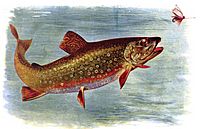
The brook trout is a very popular fish for anglers, especially for those who enjoy fly fishing. For a long time, before brown and rainbow trout were introduced, the brook trout was the most sought-after fish in the U.S. Many fishing writers wrote guides about the best places to catch them.
As brook trout numbers went down near cities in the mid-1800s, anglers traveled to places like the Adirondack Mountains in New York and the Rangeley Lake region in Maine to find them. The world record for a brook trout was caught in July 1916 on the Nipigon River in northern Ontario by Dr. John W. Cook. It weighed 14.5 lb (6.6 kg)!
Today, many anglers practice catch-and-release fishing to help protect the remaining brook trout populations. Groups like Trout Unlimited work to improve air and water quality to keep brook trout healthy. Money from fishing licenses also helps restore streams to be good homes for brook trout again.
The current world angling record brook trout was caught in July 1915. A very large brook trout caught in Manitoba in 2006 weighed about 15.98 lb (7.25 kg), but it was released alive, so it doesn't count as a world record.
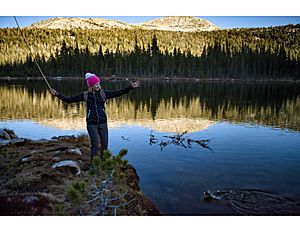
Raising Brook Trout
Brook trout are also raised by people for food. They are sold fresh or smoked. Because they need very clean water, brook trout are also used in scientific tests to see how pollution affects water.
Some businesses raise brook trout to sell to fishing clubs or groups who want to stock their own lakes or ponds. There are even places where you can pay to fish in their pond and buy the fish you catch.
Brook trout are not as commonly raised for food as some other fish because they don't grow as fast. When they are raised, they often live in large round tanks with a constant flow of water to keep them clean. They are fed special pellets made from fish oil, animal and plant protein, and vitamins.
Protecting Brook Trout
Brook trout need cold, clear, and very pure water with lots of oxygen. Since the late 1800s, many native brook trout populations in North America have disappeared. This happened because of land development, cutting down forests, and pollution from industries. Streams that became polluted, dammed, or filled with dirt often got too warm for brook trout. Other fish like smallmouth bass, perch, or introduced brown and rainbow trout then took over.
The brown trout, which is not native to North America, has replaced brook trout in many of their original homes. If brook trout populations are already struggling from too much fishing or warm temperatures, they can be easily harmed by new species being introduced. Many lake populations of brook trout have disappeared because other fish were introduced.
Besides chemical pollution and algae growth from farm runoff, air pollution has also hurt brook trout. In the U.S., acid rain has made water too acidic for brook trout in many streams, except for the very highest parts of some Appalachian streams. Brook trout in Canada have faced similar problems. The aurora trout subspecies even disappeared from the wild because of acid rain.
Today, many groups are working to bring brook trout back to their native waters. They are partnering with organizations like Trout Unlimited and government agencies to restore brook trout habitats and populations.
Brook Trout as an Invasive Species
Even though brook trout are struggling in their native homes, they are considered an invasive species in places where they have been introduced. In the northern Rocky Mountains, for example, non-native brook trout are causing problems for native cutthroat trout. Programs are in place to remove non-native brook trout to protect the native species. In Yellowstone National Park, anglers can catch as many non-native brook trout as they want in some areas. In Europe, introduced brook trout have also negatively affected native brown trout.
See also
 In Spanish: Trucha de arroyo para niños
In Spanish: Trucha de arroyo para niños




